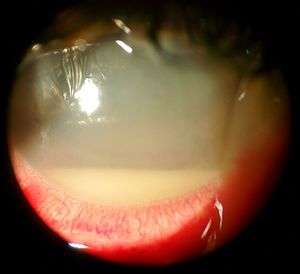Endophthalmitis
Endophthalmitis is an inflammation of the interior of the eye. It is a possible complication of all intraocular surgeries, particularly cataract surgery, with possible loss of vision and the eye itself. Infectious cause is the most common and various bacteria and fungi have been isolated as the cause of the endophthalmitis. Other causes include penetrating trauma, allergic reaction, and retained intraocular foreign bodies. Intravitreal injections expose patients to the risk of endophthalmitis, but with an incidence rate usually less than .05%.
| Endophthalmitis | |
|---|---|
 | |
| Hypopyon with hazy media | |
| Specialty | Ophthalmology |
Signs and symptoms
In cases of endophthalmitis, one usually finds a history of recent intraocular surgery or penetrating ocular trauma. In some cases of endogenous endophthalmitis—particularly in immunocompromised patients or those with diabetes—the spread of infection may have been hematogenous (via the blood-stream).
Endophthalmitis is usually accompanied by severe pain, loss of vision, and redness of the conjunctiva and the underlying episclera. Hypopyon can be present in endophthalmitis and should be looked for on examination by a slit lamp. It can first present with the 'black dot sign' (Martin-Farina sign) where patients may report a small area of loss of vision that resembles a black dot or 'fly'.
An eye exam may be indicated in severe forms of candidiasis. 1-3% of cases of candidal blood infections include endophthalmitis.
Complications
- Panophthalmitis — Progression to involve all the coats of the eye.[1]
- Corneal ulcer[1]
- Orbital cellulitis[1]
- no light perception vision[1]
Cause
- Bacteria: N. meningitidis, Staphylococcus aureus, S. epidermidis, S. pneumoniae, other streptococcal spp., Cutibacterium acnes, Pseudomonas aeruginosa, other gram negative organisms.[2]
- Viruses: Herpes simplex virus.[2]
- Fungi: Candida spp.[2] Fusarium
- Parasites: Toxoplasma gondii, Toxocara.[2]
Late-onset endophthalmitis is mostly caused by Cutibacterium acnes.[3]
Causative organisms are not present in all cases. Endophthalmitis can emerge by entirely sterile means, e.g. an allergic reaction to a drug administered intravitreally.
Diagnosis
Diagnosis: Microbiology testing. PCR. TASS vs Infectious endophthalmitis.
Prevention
A Cochrane Review sought to evaluate the effects of perioperative antibiotic prophylaxis for endophthalmitis following cataract surgery.[4] The review showed high-certainty evidence that antibiotic injections in the eye with cefuroxime at the end of surgery lowers the chance of endophthalmitis.[4] Also, the review showed moderate evidence that antibiotic eye drops (levofloxacin or chloramphenicol) with antibiotic injections (cefuroxime or penicillin) probably lowers the chance of endophthalmitis compared with injections or eye drops alone.[4] Separate studies from the research showed that a periocular injection of penicillin with chloramphenicol-suphadimidine eye drops,[5] and an intracameral cefuroxime injection with topical levofloxacin[6] resulted in a risk reduction of developing endophthalmitis following cataract surgery for subjects.
In the case of intravitreal injections, however, antibiotics are not effective. Studies have demonstrated no difference between rates of infection with and without antibiotics when intravitreal injections are performed.[7] The only consistent method of antibioprophylaxis in this instance is a solution of povidone-iodine applied pre-injection.[8]
Treatment
The patient needs urgent examination by an ophthalmologist, preferably a vitreoretinal specialist who will usually decide for urgent intervention to provide intravitreal injection of potent antibiotics. Injections of vancomycin (to kill Gram-positive bacteria) and ceftazidime (to kill Gram-negative bacteria) are routine. Even though antibiotics can have negative impacts on the retina in high concentrations, the facts that visual acuity worsens in 65% of endophthalmitis patients and prognosis gets poorer the longer an infection goes untreated make immediate intervention necessary.[9] Endophthalmitis patients may also require an urgent surgery (pars plana vitrectomy), and evisceration may be necessary to remove a severe and intractable infection which could result in a blind and painful eye.
Steroids may be injected intravitreally if the cause is allergic.
In patients with acute endophthalmitis, combined steroid treatment with antibiotics have been found to improve visual outcomes, versus patients only treated with antibiotics, but any improvements on the resolution acute endophthalmitis is unknown.[10]
References
- Goldenberg DT, Harinandan A, Walsh MK, Hassan T (Spring 2010). "Serratia Marcescens Endophthalmitis After 20-Gauge Pars Plana Vitrectomy". Retinal Cases & Brief Reports. 4 (2): 140–2. doi:10.1097/ICB.0b013e31819955bf. PMID 25390387.
- Forbes BA, Sahm DF, Weissfeld AS. Bailey & Scott's Diagnostic Microbiology. 12th Edition. Mosby Elsevier, 2007. p. 834.
- Shirodkar AR, Pathengay A, Flynn HW, Albini TA, Berrocal AM, Davis JL, Lalwani GA, Murray TG, Smiddy WE, Miller D (March 2012). "Delayed- versus acute-onset endophthalmitis after cataract surgery". Am. J. Ophthalmol. 153 (3): 391–398.e2. doi:10.1016/j.ajo.2011.08.029. PMC 3381653. PMID 22030353.
- Gower EW, Lindsley K, Tulenko SE, Nanji AA, Leyngold I, McDonnell PJ (February 2017). "Perioperative antibiotics for prevention of acute endophthalmitis after cataract surgery". Cochrane Database Syst Rev. 2: CD006364. doi:10.1002/14651858.CD006364.pub3. PMC 5375161. PMID 28192644.
- Christy NE, Sommer A (1979). "Antibiotic prophylaxis of postoperative endophthalmitis". Annals of Ophthalmology. 11 (8): 1261–1265. PMID 318049.
- Endophthalmitis Study Group; European Society of Cataract; Refractive Surgeons (2007). "Prophylaxis of postoperative endophthalmitis following cataract surgery: results of the ESCRS multicenter study and identification of risk factors". Journal of Cataract and Refractive Surgery. 33 (6): 978–988. doi:10.1016/j.jcrs.2007.02.032. PMID 17531690.
- d’Azy, Cédric Benoist; Pereira, Bruno; Naughton, Geraldine; Chiambaretta, Frédéric; Dutheil, Frédéric (2016-06-03). "Antibioprophylaxis in Prevention of Endophthalmitis in Intravitreal Injection: A Systematic Review and Meta-Analysis". PLOS ONE. 11 (6): e0156431. doi:10.1371/journal.pone.0156431. ISSN 1932-6203. PMC 4892688. PMID 27257676.
- de Caro, John J.; Ta, Christopher N.; Ho, Hoai-Ky V.; Cabael, Lorella; Hu, Nan; Sanislo, Steven R.; Blumenkranz, Mark S.; Moshfeghi, Darius M.; Jack, Robert (2008-06-01). "Bacterial contamination of ocular surface and needles in patients undergoing intravitreal injections". Retina (Philadelphia, Pa.). 28 (6): 877–883. doi:10.1097/IAE.0b013e31816b3180. ISSN 0275-004X. PMID 18536606.
- Dossarps, Denis; Bron, Alain M.; Koehrer, Philippe; Aho-Glélé, Ludwig S.; Creuzot-Garcher, Catherine (2016). "Endophthalmitis after intravitreal injections: Incidence, presentation, management, and visual outcome". American Journal of Ophthalmology. 160 (1): 17–25.e1. doi:10.1016/j.ajo.2015.04.013. PMID 25892127.
- Kim CH, Chen MF, Coleman AL (February 2017). "Adjunctive steroid therapy versus antibiotics alone for acute endophthalmitis after intraocular procedure". Cochrane Database Syst Rev. 2: CD012131. doi:10.1002/14651858.CD012131.pub2. PMC 5419424. PMID 28225198.
External links
| Classification | |
|---|---|
| External resources |